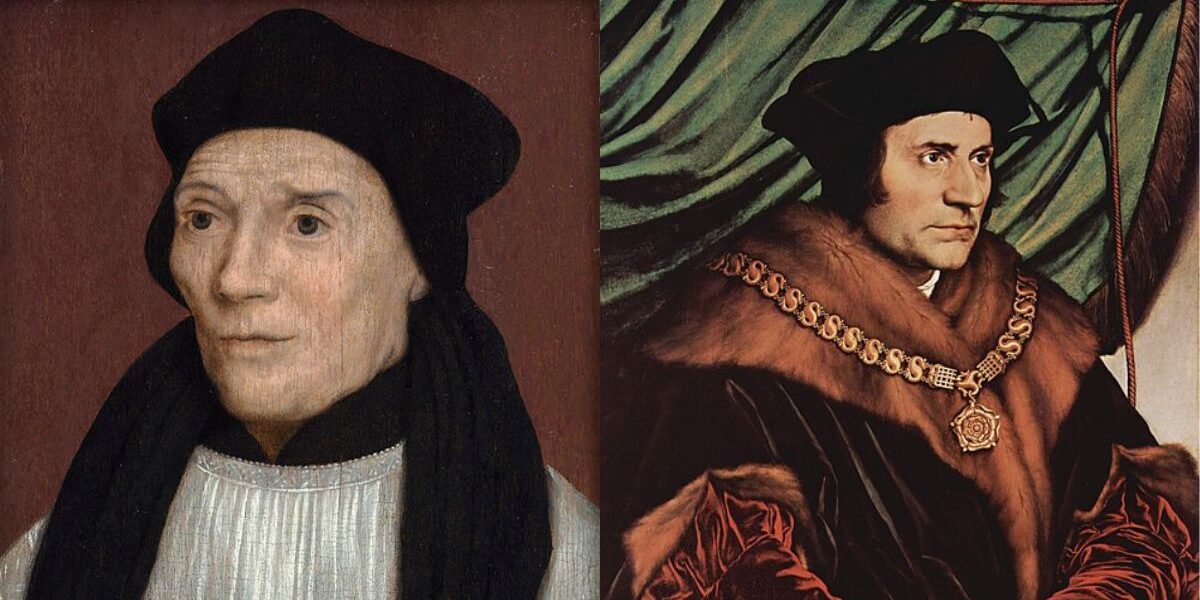Our martyr patron, St Thomas More (1478-1535), shares his memorial day in the Church’s liturgical calendar on June 22 with his older friend and cardinal and Bishop of Rochester, St John Fisher (1469-1535). The date June 22 is the venerable cardinal’s execution date, while More was beheaded two weeks later on July 6.
The More-Fisher pair illustrates an inspiring complement to each other.
They both remind us that in our centre’s endeavours to establish an intellectual and cultural resurgence for Australia, we can model the collaboration between lay people and the descendants of the apostles.
Indeed over the years, some notable and diverse bishops have supported the TMC with their presence, thoughts and writing: Cardinal George Pell; bishop, philosopher and later Archbishop of Hobart, Eric D’Arcy; Archbishop Barry Hickey of Perth; Bishop William Brennan of Wagga; Bishop Kevin Manning of Parramatta; and, while auxiliaries in Melbourne, Peter Elliott and Mark Coleridge.
It is encouraging that more recent bishops are interested in our work and presence today. We aim to interview them and share their thoughts with you in the months ahead (keep an eye on our YouTube channel and webinars).
After their deaths, Saints John Fisher and Thomas More were instantly recognised as martyrs and heroes of moral integrity throughout the Europe of their day.
Along with many other heads of state and scholars, the Dutch Christian humanist, Desiderius Erasmus (1466-1536), deplored the executions. He wrote, afflicted with grief and shock at the alarming absolutism in the King’s power: “The Bishop of Rochester and of Thomas More, who was the chief magistrate of his country, whose heart was whiter than snow, a genius such as England never had before, nor ever will have again, a country by no means lacking genius.”
Their joint canonisation took place at the hands of Pope Pius XI just 90 years ago and 400 years after their execution. That it was an important event to the Church in 1935 is evidenced by this wonderful and somewhat nail-biting video of Sanpietrini (the workmen of St Peter’s Basilica) clambering high up St Peter’s Dome placing candles for the celebration (trigger alert: there was a very different idea of worker safety in those days).
Prior to this, Pope Pius XI had a keen interest in the role of the laity in restoring Christian society and Catholic leadership after the existential, social and geographical devastation of the Great War.
In declaring the Kingship of Our Lord Jesus Christ in 1925 with his encyclical Quas Primas, Pope Pius XI aimed to mark the 16 centuries since the Council of Nicaea and to call all the baptised to receive “the reign of Christ” in their minds, hearts and wills. But Pope Pius’ intent was not only for a spiritual and moral restoration of “the kingdom of Christ”, but also a rejection of the destructive anti-religious and anti-human ideologies which were sweeping the world in the wake of World War I.
Pius writes: “When once men recognize, both in private and in public life, that Christ is King, society will at last receive the great blessings of real liberty, well-ordered discipline, peace and harmony.” (n.19)
At the canonisation, Pope Pius wrote of the two English martyrs as men of prayer and virtue, as defenders of the truth, protectors of the poor, champions of religion and of the integrity of marriage against the ambitions of King Henry VIII and the vested interests of those supporting him:
“They, the bright champions and the glory of their nation, were given to the Christian people, in the words of the prophet Jeremias, ‘as a fortified city, and a pillar of iron, and a wall of brass’. Therefore they could not be shaken by the fallacies of heretics, nor frightened by the threats of the powerful.”
In so many ways, the two great English saints – both deeply devout, cultured and intelligent Christian men, initially liked and admired by the King, in favour of the expansion of biblical languages and knowledge of the scriptures, loyal Englishmen, universally admired around Europe and both friends to each other – stand together as inspiration for the TMC.
Cardinal Fisher oversaw the revival of new strands in education, including the revival of the University of Cambridge. Thomas More was an exemplar of the public layman, at one stage the highest lay figure in the land, who sought to reflect from his private life of prayer and generous humour the importance of the rule of law and the common good.
In his groundbreaking address to the British Parliament in September 2010 at Westminster Hall, Pope Benedict XVI praised the Westminster system of the rule of law and Britain’s leadership in the overcoming of slavery, but argued that the ethical example of St Thomas More must be kept alight:
“There is widespread agreement that the lack of a solid ethical foundation for economic activity has contributed to the grave difficulties now being experienced by millions of people throughout the world. Just as ‘every economic decision has a moral consequence’ (Caritas in Veritate, 37), so too in the political field, the ethical dimension of policy has far-reaching consequences that no government can afford to ignore.”
May we continue to heed that connection between ethical and spiritual formation and our vocations towards the wider good, as well as our Final Good in the Lord.
Anna Krohn
Executive Director
Thomas More Centre
The images of John Fisher and Thomas More are in the public domain and were taken from Wikimedia Commons.







